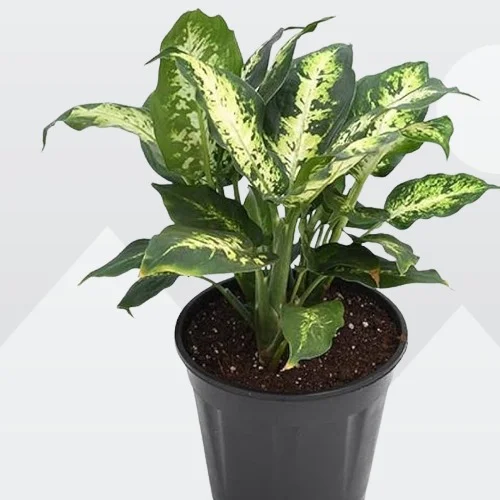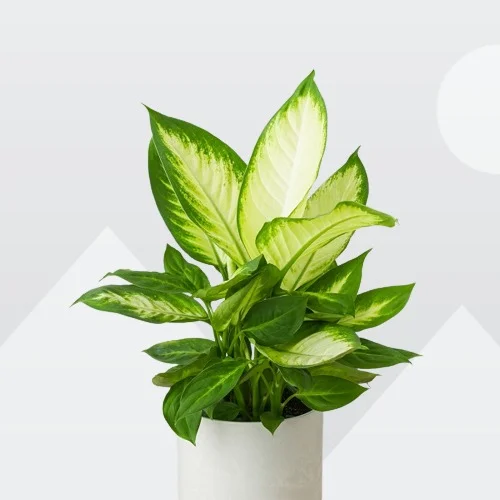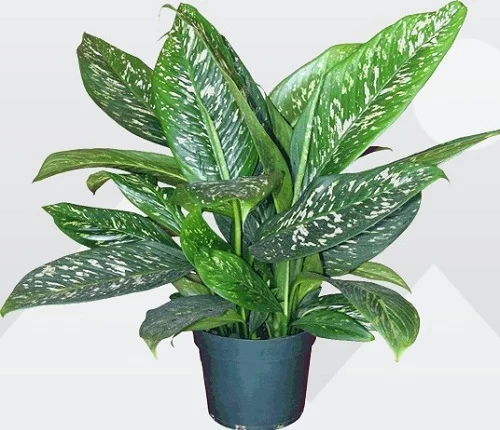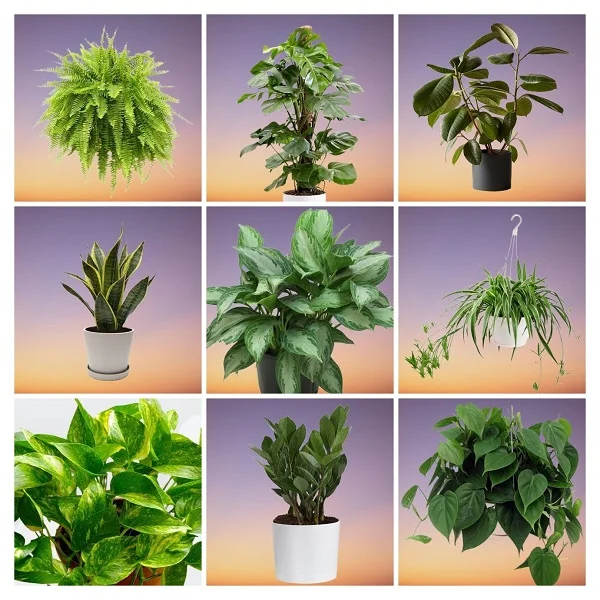How to Grow and Care for Dumb Canes (Dieffenbachia) Indoors
Some links in this post may be affiliate links
Dumb Canes (Dieffenbachia) flourish in bright indirect light, warm and humid conditions, and moderately moist, fertile, well-drained soils coupled with fortnightly feeding in spring and summer.
Dieffenbachias are popular tropical foliage plants as they bear large and highly decorative leaves. They are easy to grow and are also good indoor air cleaners.
The stems are straight and may grow to a height of 5 feet under room conditions. The leaves are simple and alternate containing white spots and flecks. The lower leaves will normally fall to give the plant a 'False Palm effect'.

Botanical name: Dieffenbachia
Family: Araceae
Subfamily: Aroideae
Common names: Dumb Cane
Origin
Dieffenbachia is native to the New World Tropics from Mexico and the West Indies south to Argentina.
Varieties
There are many varieties of Dumb Cane available with varied leaf patterns and not all are easy to grow. The Dieffenbachia amoena and Dieffenbachia picta varieties are fairly tolerant and easy to grow.
Dieffenbachia amoena has dark-green foliage with white bars, the stems can reach a height of 5 feet and the leaves are 1.5 feet long at maturity.
Dieffenbachia picta is the most popular, bearing oval leaves with ivory white blotches or markings.
Other varieties include Dieffenbachia oerstedii which bears all-green leaves with a prominent white mid-rib, the yellow-green Dieffenbachia bausei and the giant-leaved Dieffenbachia bowmannii among many others.
Dieffenbachia are among the best large-leafed plants that will make a bold statement in any space due to their large size and decorative leaves.
Air Purifying
According to the NASA Clean Air Study, Dumb canes were found to be among the best air-cleaning plants which remove formaldehyde, toulene and xylene from indoor air.
Are Dumb Canes poisonous?
Yes. Dumb Canes are toxic to both humans and pets as outlined by ASPCA. If the leaves are chewed or ingested, they may cause temporary swelling of the tongue and the throat which may lead to a temporary loss of speech. In severe cases suffocation may occur.
The common name, "Dumb Cane", is derived from the unpleasant effect of its poisonous sap on the mouth and throat. Keep these plants away from the reach of children and pets to avoid any mishaps. Always use hand gloves and wash your hands thoroughly after handling this plant.
Where to Buy
If you are looking to add Dieffenbachia to your plant collection, you may acquire them online from Amazon (Link to Amazon) or from Etsy (Link to Etsy).
How to Care for Dieffenbachia Indoors
To care for Dieffenbachia indoors, provide bright indirect light, warmth of 18-26, humidity of 50-55% and moderately moist, fertile, well-drained soils coupled with fortnightly feeding in spring and summer.
Dumb Canes require pruning to keep it neat, to minimize pest and disease infestations and to rejuvenate growth. Repotting is done annually at the beginning of the growing season. Keep reading for the best growing conditions and how to provide them.

Watering
How often should a Dumb Cane be watered?
Water a Dumb Cane liberally in spring and summer and allow the top 1-2 inches of soil to dry out between waterings. Keep the soil consistently moist but not soggy to prevent rotting, drooping and yellowing leaves.
Reduce watering in fall and winter to maintain the soil slightly moist as growth is reduced at this time. Do not let the soil dry out completely to prevent wilting, drooping, yellowing and browning leaves.
Use chlorine-free water to prevent staining and browning of the leaves. Ensure that the water is at room temperature to avoid cold shock as it can result in stunted growth and yellowing leaves.
Make sure that the pot has a drainage hole and the soil is well-draining to prevent waterlogging which can lead to stem-rot and eventual death of the plant.
Light Requirements
How much light does Dieffenbachia need?
Dieffenbachia grow best in bright indirect light; a spot infront of a well-lit window is perfect. Keep them away from direct sunshine to prevent scorching and or loss of leaf color.
Insufficient light will result in stunting, legginess and yellowing. Where the natural lighting is not enough, you may use full spectrum grow lights to supplement it.
Rotate the pot regularly to ensure that the plant gets light on all sides, which prevents it from bending towards the light source.
Temperature & Humidity
Dumb Cane thrives in a warmth of 18-260C. Keep it away from sources of drafts as they can lead to reduced growth, yellowing and wilting of the leaves.
Dieffenbachia prsopers in a humidity of 50-55%. However, when the temperatures are very high causing the air to become too dry, the plant with respond with brown leaf tips and edges.
To increase humidity and prevent brown leaf tips and edges, group the plants together, set the pot on a wet pebble tray or use a cool mist humidifier. You may also grow the plant in a well-lit bathroom, kitchen and other moist areas in the home.
Do not mist the leaves and maintain a good air circulation to minimize fungal diseases.
Fertilizer
What is the best fertilizer for Dieffenbachia?
Feed Dieffenbachia with a balanced, water-soluble fertilizer every 2-3 weeks in spring and summer to encourage foliage development. Withhold feeding in fall and winter (cold season) to prevent fertilizer burn as growth is minimal at this time.
Occasionally leach out accumulated salts by running a stream of water through the soil until it drains through the drainage hole. Let the water run for 5-10 minutes to get rid of most of the salts.
Potting Mix
The best potting mix for Dieffenbachia should be rich in organic matter and free-draining to prevent it from getting soggy while providing the required nutrients. A blend of 2 parts organic potting mix and 1 part perlite (for drainage) is ideal for this plant.
Repotting
Repot your Dumb Cane annually at the beginning of the growing season (spring to early summer). Use a pot 1-2 sizes larger than the current one. Ensure that the pot has a drainage hole and the soil is free-draining; never allow the roots to sit in soggy soil to prevent stem-rot and death of the plant. Check out these pots with drainage holes on Amazon.
Pruning & Maintenance
Pruning Dumb Cane involves removal of dead and yellow leaves to maintain the plant neat and tidy as well as discourage pests and diseases.
With age, Dieffenbachia becomes leggy and unattractive. Cut off the cane, leaving a 4 inches stump. The stump will resprout to produce a more compact and bushy plant. You may use the crown of leaves to propagate a new plant.
Regularly clean the leaves by damp-wiping with a soft cloth to get rid of dust and discourage pest and disease infestations.

Dumb Cane Propagation
Dumb Canes (Dieffenbachia) are propagated from stem cuttings, from the top crown of leaves or from offshoots. The best time to propagate is at the beginning of the growing season (spring to early summer) when the plant is in active growth for faster establishment.
Learn how to propagate Dumb Canes (Dieffenbachia) in 4 easy ways.
Dieffenbachia Problems & Solutions
Dieffenbachia problems indoors are brown leaves, yellow leaves, brown leaf tips, brown leaf spots, leggy growth, pests and diseases among others.
Read more on Dieffenbachia Common Problems Indoors and their Treatment.
You liked it? Share on social media.
Related Content
Amazon Associates Disclosure
Homeplantsguide.com is a participant in the Amazon Services LLC Associates Program, an affiliate advertising program designed to provide a means for sites to earn advertising fees by advertising and linking to amazon.com.





